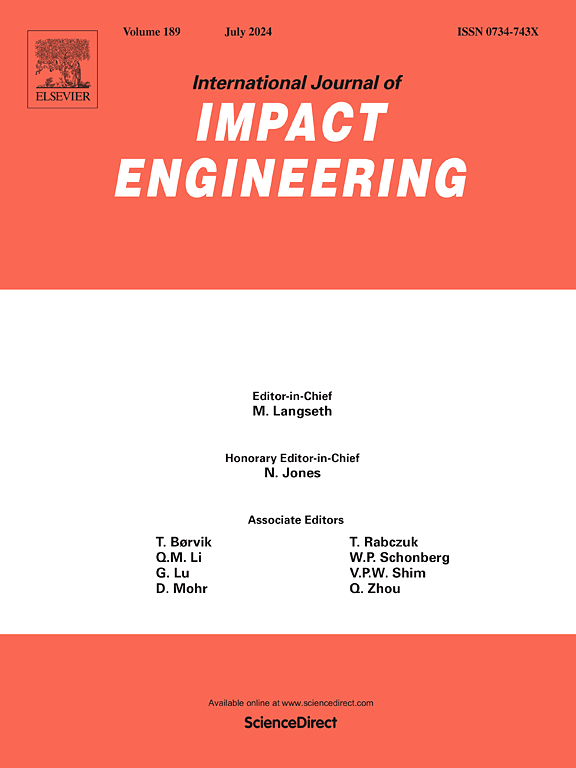Collisionless electrostatic particle-in-cell simulation of rapid target charging along an unbiased dielectric surface due to hypervelocity impact plasmas
IF 5.1
2区 工程技术
Q1 ENGINEERING, MECHANICAL
International Journal of Impact Engineering
Pub Date : 2025-05-08
DOI:10.1016/j.ijimpeng.2025.105360
引用次数: 0
Abstract
Rapid target charging is a phenomenon that has been experimentally observed in hypervelocity impact (HVI) plasmas but has been seldom modeled. In this work, we implement a 2D electrostatic particle-in-cell model to study voltage changes across the unbiased surface of an impacted dielectric material — namely, iron projectiles impacting SiO2, a novel configuration. We analyze both femtogram and picogram sized particles, of speeds 5 km/s and 15 km/s. Results of surface potential within the impact crater for the femtogram case demonstrate the presence of a minimal decrease in voltage before a rapid positive charging followed by rapid discharge as the surface potential descends towards 0 V. In the picogram case, we found more nuanced behavior, with a more notable rapid decrease in voltage followed by a rapid increase in voltage before subsequent discharge towards 0 V. All cases occurred within fractions of a nanosecond and show a correlation between impactor velocity and voltage magnitude, with peak voltage around 4500 V for the most extreme case. These outcomes, though occurring on a faster timescale, display similar trends to previous experimental results of aluminum-on-tungsten and aluminum-on-aluminum HVIs. The discrepancy in orders of magnitude in the discharging time indicates further investigation is required to determine the relevant physics that are missing from the presented model or possible weaknesses in the original experiments conducted.
超高速冲击等离子体沿无偏介质表面快速目标充电的无碰撞静电粒子池模拟
快速靶充能是在超高速撞击等离子体中实验观察到的现象,但很少建立模型。在这项工作中,我们实现了一个二维静电粒子电池模型来研究电压在受冲击的介电材料的无偏表面上的变化-即铁弹丸撞击SiO2,这是一种新的结构。我们分析了速度为5公里/秒和15公里/秒的飞图和皮克图大小的粒子。撞击坑内的表面电位结果表明,在表面电位下降到0 V时,在快速正电荷之前,存在最小的电压下降。在象形图的情况下,我们发现了更细微的行为,在随后的放电到0 V之前,电压迅速下降,随后电压迅速上升。所有情况都发生在几分之一纳秒内,并显示出冲击器速度和电压大小之间的相关性,最极端情况下的峰值电压约为4500 V。这些结果,虽然发生在更快的时间尺度上,但显示出与以前的钨铝和铝对铝HVIs的实验结果相似的趋势。放电时间的数量级差异表明,需要进一步调查,以确定所提出的模型中缺少的相关物理特性,或在原始实验中可能存在的弱点。
本文章由计算机程序翻译,如有差异,请以英文原文为准。
求助全文
约1分钟内获得全文
求助全文
来源期刊

International Journal of Impact Engineering
工程技术-工程:机械
CiteScore
8.70
自引率
13.70%
发文量
241
审稿时长
52 days
期刊介绍:
The International Journal of Impact Engineering, established in 1983 publishes original research findings related to the response of structures, components and materials subjected to impact, blast and high-rate loading. Areas relevant to the journal encompass the following general topics and those associated with them:
-Behaviour and failure of structures and materials under impact and blast loading
-Systems for protection and absorption of impact and blast loading
-Terminal ballistics
-Dynamic behaviour and failure of materials including plasticity and fracture
-Stress waves
-Structural crashworthiness
-High-rate mechanical and forming processes
-Impact, blast and high-rate loading/measurement techniques and their applications
 求助内容:
求助内容: 应助结果提醒方式:
应助结果提醒方式:


